Small overlap front: driver-side
Rating applies to 2009-20 models
Tested vehicle: 2015 Dodge Journey SXT 4-door 4wd
The Dodge Journey was introduced in the 2009 model year.
| Evaluation criteria | Rating |
|---|---|
| Structure and safety cage | |
| Driver injury measures | |
| Head/neck | |
| Chest | |
| Hip/thigh | |
| Lower leg/foot | |
|
Driver restraints and dummy kinematics
The dummy’s head barely contacted the frontal airbag before sliding off the left side as the steering column moved 14 cm to the right. The side curtain airbag did not deploy, leaving the dummy's head vulnerable to contacts with side structure and outside objects. | |
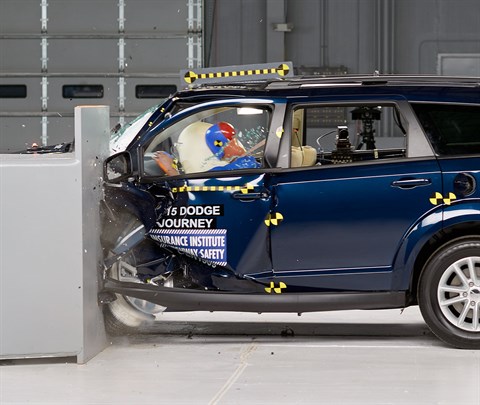
Action shot taken during the small overlap frontal crash test.
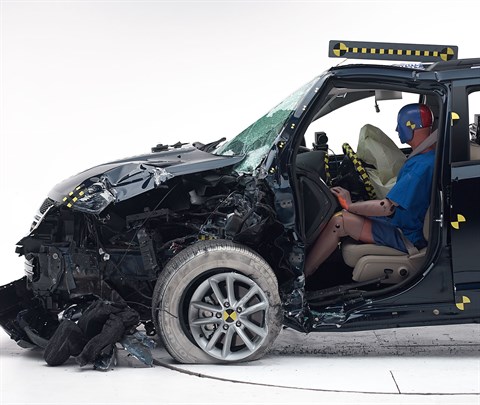
The dummy's position in relation to the door frame, steering wheel, and instrument panel after the crash test indicates that the driver's survival space was not maintained well.

During the crash, the dummy's head and torso barely contacted the airbag before sliding off to the left as the steering column moved to the right. The side curtain airbag did not deploy.
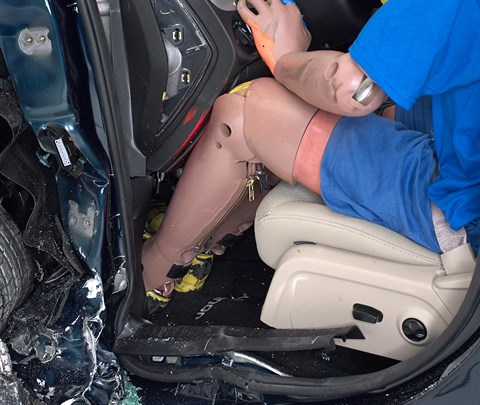
Door hinge pillar and instrument panel intrusion was extensive and contributed to a significant risk of injuries to the left hip and left knee and a moderate risk to the right lower leg.
Moderate overlap front: original test
Rating applies to 2009-20 models
Tested vehicle: 2009 Dodge Journey SXT 4-door 4wd
The Dodge Journey was introduced in the 2009 model year.
| Evaluation criteria | Rating |
|---|---|
| Overall evaluation | |
| Structure and safety cage | |
| Driver injury measures | |
| Head/neck | |
| Chest | |
| Leg/foot, left | |
| Leg/foot, right | |
| Driver restraints and dummy kinematics | |
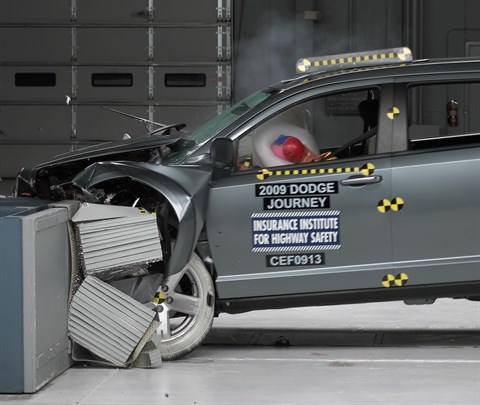
Action shot taken during the frontal offset crash test.

The dummy's position in relation to the steering wheel and instrument panel after the crash test indicates that the driver's survival space was maintained well.
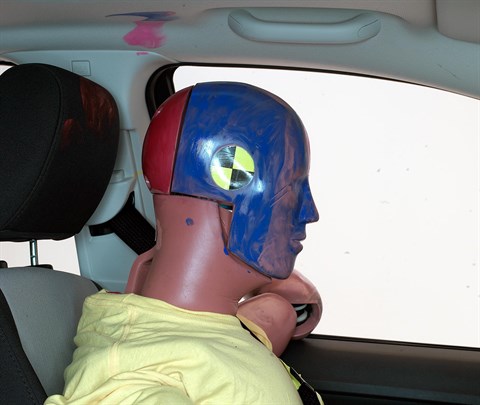
Smeared pink greasepaint indicates where the dummy's head hit the roof rail and B-pillar during rebound. Head acceleration from this hit was low.
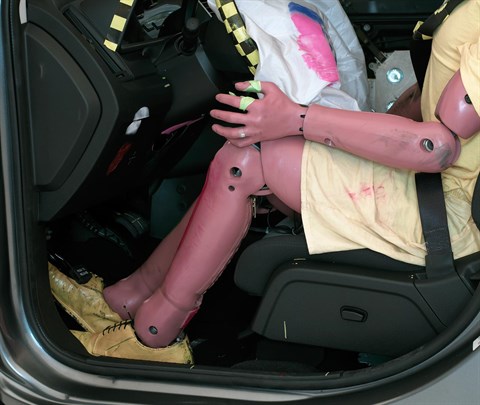
Intrusion into the driver's space was minimal, and all leg and foot injury measures were low.
Side: original test
Rating applies to 2009-20 models
Tested vehicle: 2009 Dodge Journey SXT 4-door 4wd with standard head curtain airbags for all three rows of seats and standard front seat-mounted torso airbags
The Dodge Journey was introduced in the 2009 model year.
| Evaluation criteria | Rating |
|---|---|
| Overall evaluation | |
| Structure and safety cage | |
| Driver injury measures | |
| Head/neck | |
| Torso | |
| Pelvis/leg | |
| Driver head protection | |
| Rear passenger injury measures | |
| Head/neck | |
| Torso | |
| Pelvis/leg | |
| Rear passenger head protection | |
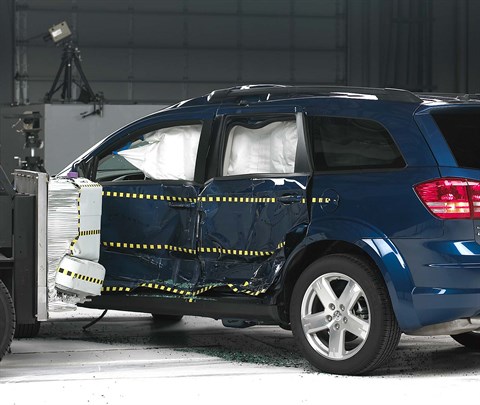
View of the vehicle and barrier just after the crash test.

View of the vehicle after the crash with doors removed, showing the side airbags and damage to the occupant compartment.

Smeared greasepaint shows where the driver dummy's head was protected from being hit by hard structures by the side airbags.
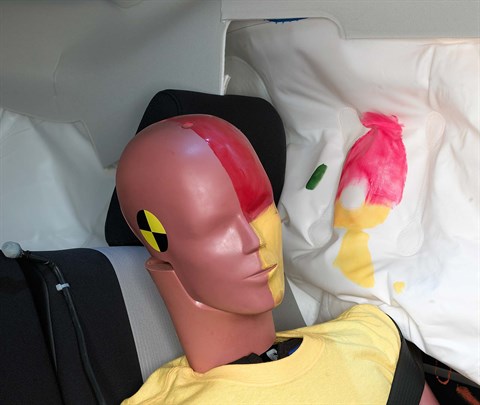
Smeared greasepaint shows where the rear passenger dummy’s head was protected by the side airbag.
Roof strength
Rating applies to 2009-20 models
Tested vehicle: 2010 Dodge Journey SXT 4-door 4wd
| Overall evaluation | |
|---|---|
| Curb weight | 4,318 lbs |
| Peak force | 19,649 lbs |
| Strength-to-weight ratio | 4.55 |
Head restraints & seats
Seat type: Manual - power cloth seats AHR
| Overall evaluation | |
|---|---|
| Dynamic rating | |
| Seat/head restraint geometry |
About the head restraint & seat test
Currently, IIHS tests apply only to front seats.
Headlights
Trim level(s)
- SE trim
- Crossroad trim
| Evaluation criteria | Rating |
|---|---|
| Low-beam headlight type | Halogen reflector |
| High-beam headlight type | Halogen reflector |
| Curve-adaptive? | No |
| High-beam assist? | No |
|
Overall rating | |
| Distance at which headlights provide at least 5 lux illumination: | |
Low beams
On the straightaway, visibility was fair on the left side of the road and inadequate on the right side. On curves, visibility was inadequate in all 4 tests.
The low beams never exceeded glare limits.
High beams
On the straightaway, visibility was good on the right side of the road and fair on the left side. On curves, visibility was inadequate in all 4 tests.
Child seat anchors
Rating applies to 2015-20 models
| Evaluation criteria | Rating |
|---|---|
| Overall evaluation | |
| Vehicle trim | SXT |
| Seat type | cloth |
This vehicle has 2 rear seating positions with complete child seat attachment (LATCH) hardware.
It has 1 additional seating position with a tether anchor, a single lower anchor and the ability to borrow the second anchor from another position.
Note: When anchors are borrowed, they aren't available to use in their designated positions.
| Evaluation criteria | Rating |
|---|---|
| Overall evaluation | |
| Vehicle trim | SXT |
| Seat type | cloth |
| Rating icon | Rating |
|---|---|
| G | Good |
| A | Acceptable |
| M | Marginal |
| P | Poor |
| Seating positions that rely on borrowed lower anchors or have only a tether anchor available are not rated. | |
thether anchor symbol | Tether anchor |
lower anchor symbol | Lower anchors |
| Lower anchor(s) can be borrowed from adjacent positions(s) | |
| No hardware available |
Details by seating position
| Position | Rating |
|---|---|
| 1 | |
| Tether anchor | |
| hard-to-find location | |
| other hardware could be confused for anchor | |
| Lower anchors | |
| not too deep in seat | |
| not too much force needed to attach | |
| easy to maneuver around anchors | |
| 2 | |
| Tether anchor | |
| hard-to-find location | |
| other hardware could be confused for anchor | |
| Lower anchors | |
| 1 dedicated anchor and 1 that can be borrowed from seat 1 | |
| not too deep in seat | |
| not too much force needed to attach | |
| difficult to maneuver around anchors | |
| 3 | |
| Tether anchor | |
| hard-to-find location | |
| other hardware could be confused for anchor | |
| Lower anchors | |
| too deep in seat | |
| not too much force needed to attach | |
| easy to maneuver around anchors |
